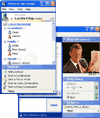|
|
 Instant
Messaging for Business Instant
Messaging for BusinessIf youíve got teenagers in your home, theyíre probably online right now, sending instant messages to their friends. And you may be wondering what the attraction is. If they want to stay in touch, why not just pick up the phone? It took me a long time to understand the attraction Ė and even longer to start using instant messaging (IM) in my business life. First, I wasnít clear on the difference between IM and chat rooms. (I still donít get chat rooms. Itís like walking into a chaotic room full of strangers all talking/lying at the same time.) The only thing IM has in common with chat is immediacy. You type something, hit enter, and your message appears ďinstantlyĒ on the other personís computer screen. The difference is that you and the other person have agreed to have this little private conversation. On that basis, IM is much more intimate and interactive than email. Email is ďasynchronous.Ē You and the other person can respond to each otherís messages at your convenience Ė unlike IM or a phone conversation, you donít need to be connected in ďreal time.Ē However, since you donít always know how long itíll take your message to arrive, and how quickly the other person will respond, email can be really frustrating when youíre trying to get something accomplished or settled quickly. Why not pick up the phone and just call? Good question. This was my main objection to IM: seemed silly to type when you can just talk. Actually though, there are times when IM is superior to telephoning, and other times when itís a great concurrent addition to a phone call. These days I often send IMís to a colleague or client when weíre on the phone together. Itís particularly good when weíre doing research or problem-solving on the web and can instantly send long, complicated web links to one another Ė which arrive blue, underlined, and clickable. Even on a stand-alone basis, IM has advantages over a phone call. I donít know about you, but when Iím on the phone with somebody, I give that call my full concentration and donít try to do any other tasks (typing, clicking on emails, shuffling papers, etc.) Even if itís not audible, the other person can tell youíre not all there. Thatís what won me over. When youíre IMíing, you can do other stuff. You donít have to type a reply the moment the other person hits enter. Itís OK to take a minute or two to compose a reply, and you can also change your ďstatusĒ flag to indicate youíre on a phone call, busy, or have stepped away. I often have several IM conversations going on at once Ė each in a separate little window Ė and can give appropriate attention to every one of them. (Being a fast typist helps in this situation.) There are other positives as well, but also some negatives. People youíre IMíing with (your ďbuddy listĒ) can tell when youíre actually at your computer, and you may not want this. (However, there are ways to trick the system and spoof your status display on other computers.) A bigger negative about IM is that it isnít ďuniversal.Ē There are four different, incompatible IM services in common use: AIM (AOLís IM), Yahoo Messenger, ICQ, and Windows Messenger (A.K.A. MSN Messenger). Both you and the other party need to be on the same system to communicate. For years now, people have been talking about interoperability, but it hasnít happened yet and isnít likely to anytime soon. Itís yet another case where AOL has put its proprietary business concerns ahead of the best interests of its members. Fortunately, most serious IM business users are now on Windows/MSN Messenger. Itís included in Windows XP and a free easy download for everybody else. There are versions for earlier versions of Windows, the Mac, and Pocket PC. It also has some nice collaborative features like webcam videoconferencing. You can make Windows Messenger even better by downloading the free utility called MsgPlus. Itíll add messaging logging (a must for business use), get rid of the ad banners, and do other useful things. Another option is to use a program like Trillian which can talk to all the major IM services in a single integrated application. If youíd like more info on IM for business, click here for an excellent article by Anne Stuart in the July 2002 issue of Inc. Magazine, and a great sidebar on IM Etiquette from Inc.com. |
